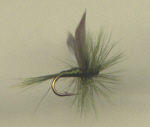Wet
A fly lure or Fly, or "pattern", in terms of sport fishing and fly fishing, is an artificial lure tied, most commonly, with thread, feathers, and fur, but may also include, lead (for weight), ribbon, tinsel, beads and other assorted materials. more...
Fly tying is becoming common practice in fly fishing. Many fly fishers tie their own flies, either following patterns in books, natural insect examples, or using their own imagination. The technique involves attaching small pieces of feathers, animal fur and other materials on a hook in order to make it attractive to fish. This is made by wrapping thread tightly around the hook and tying on the desired materials.
Generally, fly patterns are considered either "imitations" or "attractors." Imitations seek to deceive fish through the life-like imitation of insects on which the fish may feed. Attractors, which are often brightly colored, seek to draw a strike by arousing a response in the fish unrelated to feeding, or so it is thought.
There are four main categories of flies: dry fly, wet fly,streamer fly and nymph .
Dry fly
A dry fly resembles an insect floating on the water surface. Dry flies can also imitate mice, frogs, and snakes. A dry fly is often tied on a light hook so it can float easily.
Dry flies can be tied to imitate insects on the water, such as Pale Morning Duns, or to attract fish to rise without imitating any one specific insect, such as a Royal Wulff or Adams dry fly. Traditional dry flies have a few basic parts, tail, body, wing, hackle, and head. Floatation of the fly can be achieved in a variety of ways. Traditional dry flies use the surface tension of water to float. The fly will ride on the hackle and tail, and in some cases the hook point will not break through the surface. Closed-cell foam can be used in the construction or sometimes a CDC feathers, to hold molecules of air. Some dry flies have to be oiled with special dry fly floatant before presentation to further enhance the floatation.
Dry fly technique
Fishing technique with dry flies is what makes fly fishing so easily distinguishable. In order for the dry fly to float unobstructed, it has to be dried after it is pulled out of the water for another round of presentation. This is accomplished by several rapid strokes or whips of the airborne fly line, called "false casting", in the air.
Another method is squishing the dry fly in amadou to suck out the absorbed water in the dry fly.
Also, several varieties of artificial floatant are available, which are applied to the fly in order to boost water repellency and buoyancy. Gasoline and other toxic materials were once used as floatant, but are now obsolete and have been replaced by more ecologically friendly, non-toxic substances.
Dry flies can be fished upstream or downstream. Casting upstream generally keeps the angler out of the view of the fish while casting downstream may be easier to get at productive holes.
Read more at Wikipedia.org



